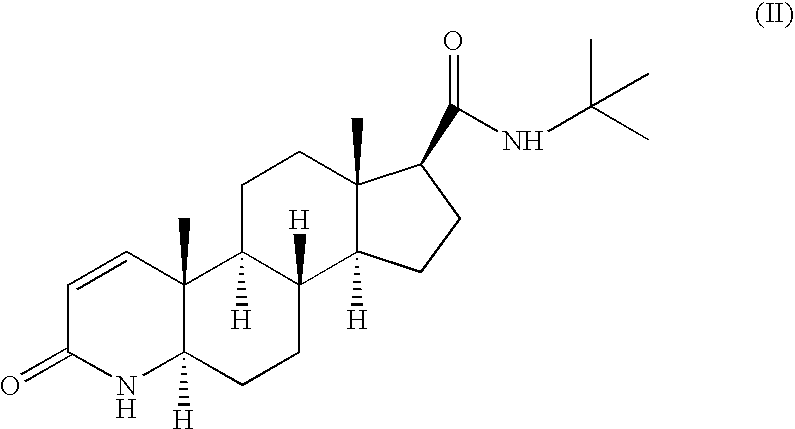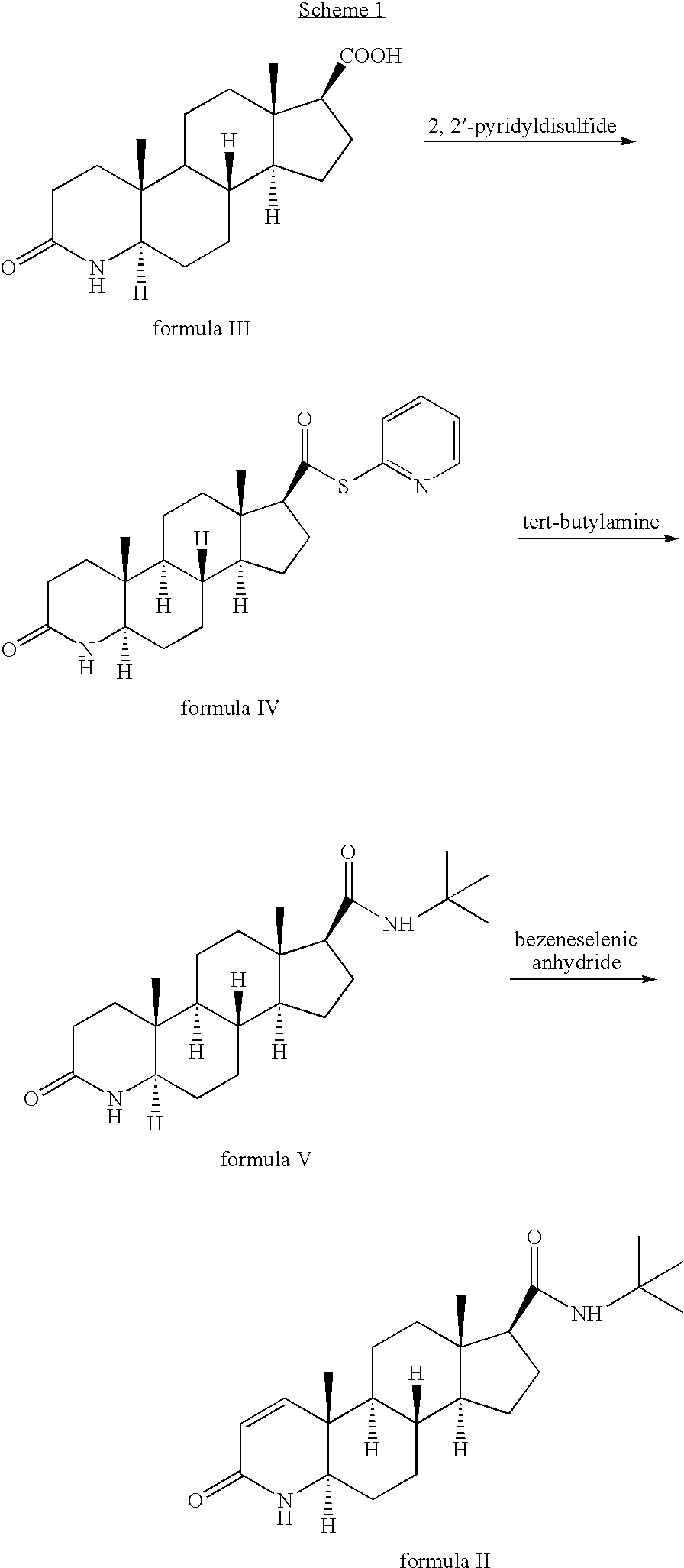Method for the preparation of highly pure 1-androstene derivatives
- Summary
- Abstract
- Description
- Claims
- Application Information
AI Technical Summary
Benefits of technology
Problems solved by technology
Method used
Image
Examples
preparation example 1
Preparation of benzothiazolyl 3-oxo-4-aza-5α-androstane-17β-thiocarboxylate
[0032] 200 g of 3-oxo-4-aza-5α-androstane-17β-carboxylic acid and 250 g of bisbenzothiazolylthioester (bis-BTS) were mixed in 3 l of methylenechloride, and stirred at room temperature for 30 minutes. 197 g of triphenylphosphine was added thereto, stirred for 30 minutes and 105 ml of triethylamine diluted with 200 ml of methylenechloride was added dropwise thereto over a period of 30 minutes, followed by stirring the mixture at room temperature for 4 hours. The precipitation formed was filtered, washed successively with methylenechloride and diethylether, and dried at 40° C. overnight to obtain 281 g of the title compound (yield: 96%) as a pale white solid.
[0033] m.p.: 245˜247° C.; 1H-NMR (300 MHz, CDCl3, δ); 8.02 (d, 1H), 7.91 (d, 1H), 7.50 (m, 2H), 5.54 (brs, 1H), 3.06 (dd, 1H), 2.76 (t, 1H), 2.45 (m, 2H), 2.26 (m, 2H), 1.9 (m, 2H), 1.75 (m, 2H), 1.65 (m, 1H), 1.51˜1.34 (m, 7H), 1.21 (m, 1H), 1.12 (m, 1H),...
preparation example 2
Preparation of N-(tert-butyl)-3-oxo-4-aza-5α-androstane-17β-carboxamide (compound of formula (XIIIa))
[0034] 281 g of benzothiazolyl 3-oxo-4-aza-5α-androstane-17β-thiocarboxylate obtained in Preparation Example 1 was added to 2.81 of dimethylformamide and 315 ml of tert-butylamine was added thereto, followed by stirring the mixture at 50° C. for 4 hours. The resultant was cooled to about 10° C., 5.6 l of water was slowly added thereto and stirred at room temperature for an hour. The precipitation formed was filtered, washed successively with water and isopropylether, and dried at 40° C. overnight to obtain 206 g of the title compound (yield: 92%) as a pale white solid.
[0035] m.p.: 280˜284° C.; 1H-NMR (300 MHz, CDCl3, δ); 5.66 (brs, 1H), 5.07 (brs, 1H), 3.07 (dd, 1H), 2.41, (m, 2H), 2.12 (m, 2H), 2.10˜1.80 (m, 3H), 1.8˜1.52 (m, 4H), 1.51˜1.41 (m, 4H), 1.35 (s, 9H), 1.3˜1.18 (m, 2H), 1.15˜0.92 (m, 2H), 0.91 (s, 3H), 0.90˜0.70 (m, 1H), 0.69 (s, 3H)
preparation example 3
Preparation of N-(tert-butyl)-2-iodo-3-oxo-4-aza-5α-androstane-17β-carboxamide (compound of formula (XII) wherein R is tert-butylamino)
[0036]205 g of N-(tert-butyl)-3-oxo-4-aza-5α-androstane-17β-carboxamide obtained in Preparation Example 2 and 248 ml of tetramethylethylenediamine were added to 2 l of toluene, cooled to 0° C., 138 ml of trimethylchlorosilane was added dropwise thereto, and stirred for 30 minutes. 208 g of iodine was added thereto in 1 / 4 portions every 30 minute over a period of 2 hours, followed by stirring the mixture for 2 hours. 2 l of 10% sodium thiosulfate was added dropwise to the mixture and stirred overnight. The precipitation formed was filtered, washed successively with water and isopropylether, and dried at 40° C. overnight to obtain 255 g of the title compound (yield: 93%) as an white solid.
[0037] m.p.: 218˜220° C.; 1H-NMR (300 MHz, CDCl3, δ); 5.82 (brs, 1H), 5.06 (brs, 1H), 4.75 (dd, 1H), 3.15 (dd, 1H), 2.56 (dd, 1H), 2.20˜1.88 (m, 4H), 1.80˜1.36 (m, ...
PUM
 Login to View More
Login to View More Abstract
Description
Claims
Application Information
 Login to View More
Login to View More - R&D Engineer
- R&D Manager
- IP Professional
- Industry Leading Data Capabilities
- Powerful AI technology
- Patent DNA Extraction
Browse by: Latest US Patents, China's latest patents, Technical Efficacy Thesaurus, Application Domain, Technology Topic, Popular Technical Reports.
© 2024 PatSnap. All rights reserved.Legal|Privacy policy|Modern Slavery Act Transparency Statement|Sitemap|About US| Contact US: help@patsnap.com










